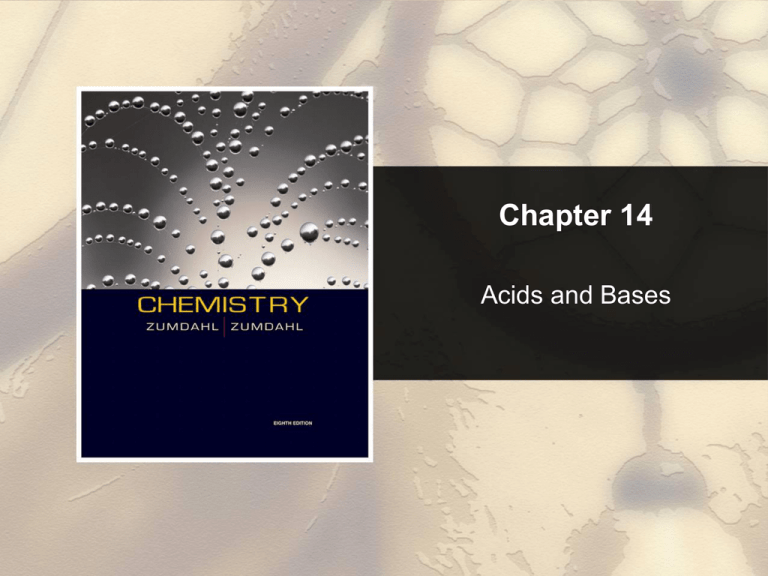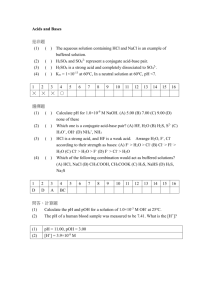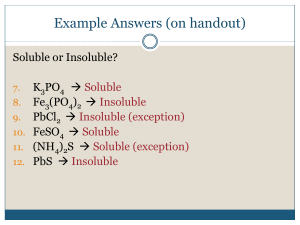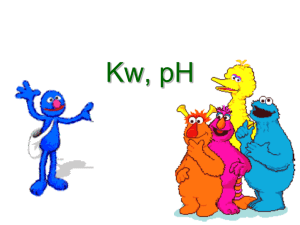
Chapter 14
Acids and Bases
Chapter 14
Table of Contents
14.1
14.2
14.3
14.4
14.5
14.6
14.7
14.8
14.9
14.10
14.11
14.12
The Nature of Acids and Bases
Acid Strength
The pH Scale
Calculating the pH of Strong Acid Solutions
Calculating the pH of Weak Acid Solutions
Bases
Polyprotic Acids
Acid–Base Properties of Salts
The Effect of Structure on Acid–Base Properties
Acid–Base Properties of Oxides
The Lewis Acid–Base Model
Strategy for Solving Acid–Base Problems: A Summary
Copyright © Cengage Learning. All rights reserved
2
Chapter 14
Table of Contents
Objectives
1. To learn about two models of acids and
bases
2. To understand the relationship of
conjugate acid-base pairs
3. To understand the concept of acid
strength
4. To understand the relationship between
acid strength and the strength of the
conjugate base
5. To learn about the ionization of water
Chapter 14
Table of Contents
A. Acids and Bases
The Arrhenius Model
• Acid – produces hydrogen ions H+ in
aqueous solution: H2SO4 Sulfuric Acid
HNO3 Nitric Acid
• HCl, HF, HBr, HI:HydroChloric,Fluoric..acid
• Base – produces hydroxide ions OH- in
aqueous solution NaOH Sodium Hydroxide
KOH Potassium Hydroxide Mg(OH)2
Chapter 14
Table of Contents
A. Acids and Bases
The Bronsted-Lowry Model
(1923 Danish/English independent submittals)
• Acid – proton donor (gives H+ )
• Base – proton acceptor (takes H+)
• The general reaction for an acid dissolving
in water is
Chapter 14
Table of Contents
A. Acids and Bases
The Bronsted-Lowry Model
• Acid-base conjugate pairs consist of an acid
that donates the H+ and the ion it becomes.
Chapter 14
Table of Contents
A. Acids and Bases
The Bronsted-Lowry Model
• Water acts as a base accepting a proton
from the acid. (B-L Base)
• hydronium ion (H3O+) (Conjugate Acid)
Chapter 14
Table of Contents
A. Acids and Bases
The Arrhenius Model is limited to Aqueous
• The Bronsted-Lowry Model can also relate
to non-aqueous reactions:
• NH3 + HCl NH4+ + Cl• CH3COOH + H2O CH3COO- + H3O +
Chapter 14
Table of Contents
A. Acids and Bases
• Identify the Bronsted-Lowry acid/base
conjugate pairs in the following reactions:
• HCl + H2O Cl- + H3O +
• NH3 + HCl NH4+ + Cl• CH3COOH + H2O CH3COO- + H3O +
Chapter 14
Table of Contents
A. Acids and Bases
• Identify the Bronsted-Lowry acid/base
conjugate pairs in the following reactions:
• HSO4- + OH- SO4-2 + H2O
• SO3-2 + H2O HSO3- + OH• NH3 + HNO3 NH4+ + NO3-
Chapter 14
Table of Contents
A. Acids and Bases
• The general acid/base pattern is:
• Acid + Base salt + water
• H__ + __OH ____ + H2O
• HCl + NaOH NaCl + H2O
• ID the Arrhenius Acid/Base and B-L Pairs…
Chapter 14
Table of Contents
B. Acid Strength
• Strong acid – completely ionized or
completely dissociated
Chapter 14
Table of Contents
B. Acid Strength
• Weak acid – low ionization of acids
Chapter 14
Table of Contents
B. Acid Strength
• A strong acid contains a
relatively weak conjugate
base.
• HCl + H2O H3O+ + Cl• Whereas the acid will
quickly donate a proton
(strong acid), the
conjugate base will not
quickly accept a proton
(weak).
Chapter 14
Table of Contents
B. Acid Strength
• Common strong acids are
– Sulfuric
acid, H2SO4
– Hydrochloric acid, HCl
– Nitric acid, HNO3
–Are weak acids the same as dilute
strong acids?
Chapter 14
Table of Contents
B. Acid Strength
• Oxyacid – acidic proton is attached to an oxygen atom
• Organic acid – have a carbon atom backbone and
commonly contain the carboxyl group
– Typically a weak acid (COOH)
Chapter 14
Table of Contents
B. Acid Strength
Chapter 14
Table of Contents
C. Water as an Acid and a Base
• Water is amphoteric
(amphiprotic) – it can
behave as either an
acid or as a base
• Amphiprotic etymology…
• ambi-Ringo Starr
• Ambigram??
ringo_starr.images6.com/ringo_starr.html
Chapter 14
Table of Contents
http://www.coolopticalillusions.com/ambigrams/funny_ambigram.htm
Chapter 14
Table of Contents
Red Rocks Amphitheatre Colorado
Chapter 14
Table of Contents
C. Water as an Acid and a Base (Amphiprotic)
• Ionization of water - ID the B-L conjugate pairs
– Concentration of hydronium and hydroxide
are equal in pure water
Chapter 14
Table of Contents
C. Water as an Acid and a Base
– Product of [H3O+] and [OH] is always
constant in all solutions.
– Water is equally both an acid and a base
Chapter 14
Table of Contents
C. Water as an Acid and a Base
pH range
0.? – 7
7 – 14
7
Chapter 14
Table of Contents
Objectives Review
1. To learn about two models of acids and bases
2. To understand the relationship of conjugate
acid-base pairs
3. To understand the concept of acid strength
4. To understand the relationship between acid
strength and the strength of the conjugate base
5. To learn about the ionization of water
6. Work Session: Page 673 # 29
Chapter 14
Table of Contents
Objectives
1. To understand pH and pOH
2. To learn to find pH and pOH for various
solutions
3. To use a calculator to find pH and [H+]
4. To learn methods for measuring pH of a
solution
5. To learn to calculate the pH of strong
acids
Chapter 14
Table of Contents
A. The pH Scale
• The “p scale” is used to express small
numbers.
• pH = log [H+]
• What is the pH if [H+] = 1 X 10 -7?
Calculator practice- do the log function?
• If [H+] = 2.3 X 10-5?
• pH = 4.64 is this acid or base?
Chapter 14
Table of Contents
A. The pH Scale
• Because the
pH scale is a
log scale
based on 10,
the pH
changes by
1 for every
power of 10
change in
the [H+].
Chapter 14
Table of Contents
A. The pH Scale
• Calculate the pH given the
following concentrations:
• [H+] = 1.0 X 10-5
• [H+] = 1.0 X 10-11
• [H+] = 3.4 X 10-4
• [H+] = 2.6 X 10-8
• [H+] = 2.3 X 10-5
• [H+] = 1.9 X 10-6
Chapter 14
Table of Contents
A. The pH Scale
• pOH scale
pOH = log [OH]
• Calculate the pOH if [OH] = 1.0 X 10-6
• pOH = 6
• remember [H+] [OH] = 1.0 X 10-14
• If [OH] = 1.0 X 10-6 , then [H+] = 1.0 X 10-8
• If [OH] = 6 , then [H+] = 8
• Since pH + pOH = 14.00
• pOH = 14.00 – pH (shortcut)
Chapter 14
Table of Contents
A. The pH Scale
•
•
•
•
•
•
•
Knowing the pH, determine the pOH:
[H+] = 1.0 X 10-5
pH = 5, pOH = 9
[H+] = 1.0 X 10-11
pH = 11, pOH = 3
[H+] = 3.4 X 10-4
pH = 3.47, pOH = ?
[H+] = 2.6 X 10-8
pH = 7.59, pOH = ?
[H+] = 2.3 X 10-5
pH = 4.64, pOH = ?
[H+] = 1.9 X 10-6
pH = 5.72, pOH = ?
Chapter 14
Table of Contents
A. The pH Scale
•
•
•
•
•
•
Can you determine the [H+] from pH?
If pH = 3.98, what is the [H+] ?
Inverse log function…..
[H+] = inverse log (-pH)
[H+] = inverse log (- 3.98)
[H+] = 1.05 X 10-4
Chapter 14
Table of Contents
A. The pH Scale
•
•
•
•
•
•
•
Calculate the [H+] given the following pH:
pH = 5
[H+] = ?
pH = 7
[H+] = ?
pH = 10.1
[H+] = ?
pH = 4.5
[H+] = ?
pH = 3.22
[H+] = ?
pH = 9.54
[H+] = ?
Chapter 14
Table of Contents
B. Measuring pH
• Indicators – substances that exhibit
different colors in acidic and basic
solutions
– In an acid solution the indicator will be in
the HIn form.
– In a basic solution the indicator will be in
the In form.
Chapter 14
Table of Contents
B. Measuring pH
– Phenolphthalein color change 8.0 – 9.8
http://antoine.frostburg.edu/chem/senese/101/acidbase/indicators.shtml
Chapter 14
Table of Contents
B. Measuring pH
– Bromothymol Blue
color change 6.0 – 7.6
http://antoine.frostburg.edu/chem/senese/101/acidbase/indicators.shtml
Chapter 14
Table of Contents
B. Measuring pH
– Thymol Blue – tri color!
http://antoine.frostburg.edu/chem/senese/101/acidbase/indicators.shtml
Chapter 14
Table of Contents
B. Measuring pH
• Other methods
– Indicator paper
– pH meter
– Cabbage juice
Chapter 14
Table of Contents
Objectives Review
1. To understand pH and pOH
2. To learn to find pH and pOH for various
solutions
3. To use a calculator to find pH and [H+]
4. To learn methods for measuring pH of a
solution
5. To learn to calculate the pH of strong acids
6. Work Session: Page 674 # 41 for 37, 43
Chapter 14
Table of Contents
Objectives
1. To learn about acid-base titrations
2. To demonstrate calculations and
techniques for titration lab
3. To understand the general characteristics
of buffered solutions
Chapter 14
Table of Contents
Chapter 14
Table of Contents
A. Acid-Base Titrations
• Titration – delivering a measured volume
of a solution of known concentration into
the solution being analyzed
• Titrant – a standard solution
• Buret – device used for accurate
measurement of the delivery of a liquid
• Stoichiometric point (equivalence point) –
when just enough titrant has been added
to react with all of the solution being
analyzed
Chapter 14
Table of Contents
A. Acid-Base Titrations
• Titration curve
(pH curve) – plot
of the data
(pH vs volume)
for a titration
Chapter 14
Table of Contents
A. Acid-Base Titrations
• HCl + NaOH NaCl + H2O
• Stoichiometrically, there is a 1 to 1 ratio of
H+ to OH- ions between HCl and NaOH
• For this reason, we can use the dilution
equation in the form MacidVacid = MbaseVbase
to determine the amount of one Molarity
solution to completely neutralize a given
amount of another Molarity solution
Chapter 14
Table of Contents
A. Acid-Base Titrations
• HCl + NaOH NaCl + H2O
• What volume of 1 M HCl would be
required to completely neutralize 20 ml of
2 M NaOH?
• MacidVacid = MbaseVbase
• Macid =
• Vacid =
• Mbase=
• Vbase=
Chapter 14
Table of Contents
A. Acid-Base Titrations
• HCl + NaOH NaCl + H2O
• What volume of 1 M HCl would be
required to completely neutralize 20 ml of
2 M NaOH?
• MacidVacid = MbaseVbase
• Macid = 1 M
• Vacid = ?
• Mbase= 2M
• Vbase= 20 ml
Chapter 14
Table of Contents
A. Acid-Base Titrations
• HCl + NaOH NaCl + H2O
• What volume of 1 M HCl would be
required to completely neutralize 20 ml of
2 M NaOH?
• MacidVacid = MbaseVbase
• Vacid = MbaseVbase
•
Macid
• Vacid = (2M)(20 ml) = 40 ml
•
(1 M)
Chapter 14
Table of Contents
A. Acid-Base Titrations
• HCl + KOH KCl + H2O
• Calculate the volume of 0.30 M HCl
needed to titrate 75.0 ml of 0.150 M KOH.
MacidVacid = MbaseVbase
• Macid =
• Vacid =
• Mbase=
• Vbase=
Chapter 14
Table of Contents
A. Acid-Base Titrations
• HCl + KOH KCl + H2O
• Calculate the volume of 0.30 M HCl
needed to titrate 75.0 ml of 0.150 M KOH.
MacidVacid = MbaseVbase
• Macid = 0.30 M
• Vacid = ?
• Mbase= 0.150 M
• Vbase= 75.0 ml
Chapter 14
Table of Contents
A. Acid-Base Titrations
• HCl + KOH KCl + H2O
• Calculate the volume of 0.30 M HCl
needed to titrate 75.0 ml of 0.150 M KOH.
MacidVacid = MbaseVbase
• Vacid = MbaseVbase
•
Macid
• Vacid = (0.150M)(75 ml) = 37.5 ml HCl
•
(0.30 M)
Chapter 14
Table of Contents
A. Acid-Base Titrations (Lab Prep)
• HCl + NaOH NaCl + H2O
• Using (MacidVacid = MbaseVbase),
calculate the volume of 1.0 M HCl required
to titrate 20.0 ml of 0.5 M, 1.0 M, and 2.0
M NaOH to the equivalence point. Show
the calculations and record the HCl
volumes in Table 1.
Chapter 14
Table of Contents
B. Buffered Solutions
• Buffered solution – resists a change in its
pH when either an acid or a base has
been added
– Presence of a weak acid and its
conjugate base buffers the solution
Chapter 14
Table of Contents
B. Buffered Solutions
Chapter 14
Table of Contents
Objectives Review
1. To learn about acid-base titrations
2. To demonstrate calculations and
techniques for titration lab
3. To understand the general characteristics
of buffered solutions
4. Work Session: Next slide…
Chapter 14
Table of Contents
C. Lab Techniques
•
•
•
•
Buret Filling
Buret Clearing
Buret Reading
Carol
Chapter 14
Table of Contents
Work Session
1. What is true about [H+] and [OH-] at the
equivalence point?
2. List two ways to determine the
equivalence point.
3. Determine the volume of 0.250 M NaOH
needed to titrate 125.0 ml of 0.150 M HCl.
Chapter 14
Table of Contents
Objectives Review
1. This is the end of the required material for
this chapter…
Section 16.2
Determining the Acidity of a Solution
A. The pH Scale
Section 16.2
Determining the Acidity of a Solution
A. The pH Scale
Section 16.2
Determining the Acidity of a Solution
C. Calculating the pH of Strong Acid Solutions
• Determine the [H+].
• pH = log[H+]








